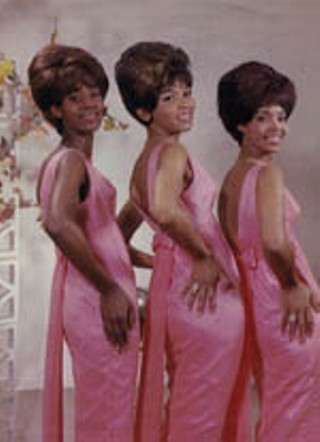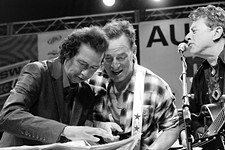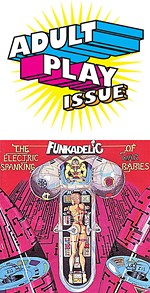I'd Much Rather Be With the Girls
'Girl Group Sounds' in a hat box
By Margaret Moser, Fri., Dec. 9, 2005

Nothing ever conveyed the exuberant joy and bitter heartache of young love like a heavenly choir of girls' angel voices. One Kiss Can Lead to Another: Girl Group Sounds Lost and Found is a fresh take on the girl-groups theme, and Rhino delightfully avoids the hackneyed da-doo-ron-ron in favor of the long-forgotten bop-bop-suki-doo-wah dah.
The inspired packaging tucks the 120-song, 4-CD set into a black-and-white striped hatbox. The digipak covers resemble the accessory no girl would be caught dead without: the powder compact, complete with foil mirrors. The four discs are designed as powder puffs; lift the CDs and underneath are the powder trays. The bow on the bouffant is the exhaustive 200-page booklet, created diary style.
This is the real thing, what a box set should be. It's your mother's taffeta prom dress whispering sweet nothings in the back of the closet, layered in pastel tissue paper and still iridescent. It's the dried white carnation corsage pressed between the pages of a dusty diary, its spicy scent and ribbons yellowed by time. It's the poem of everlasting love, written in blue ink during class and ripped from the spiral notebook, folded and forgotten in an old purse. When the set's producer Sheryl Farber writes that "60s girl group music was considered a mere footnote of rock history," she's not kidding.
Therein lies the intricacy of the genre. Most such collections focus on labels or genres, but Girl Group Sounds crosses the ocean to bring Brit birds such as Lulu, Sandie Shaw, Cilla Black, Julie Driscoll, Petula Clark, and Dusty Springfield in line with their American sisters including Brenda Lee, Little Eva, Lesley Gore, Mary Wells, Connie Francis, and Cher. Those are names familiar to music lovers, but Farber and co-producer Gary Stewart spotlight lesser-knowns, regional favorites, and one-hit wonders. Hence, we get Twinkle, Twiggy (!), Nita Rossi, Sylvan, Mally Page, and Little Frankie from the other side of the pond, and Yvonne Carroll, Cathy Saint, Gayle Harris, Dawn (not Tony Orlando's), Dorothy Berry, and Alder Ray on this side.
Yes, the Ronettes ("He Did It"), Shirelles ("Please Go Away"), Chiffons ("I Have a Boyfriend"), and Supremes ("When the Lovelight Starts Shining Through His Eyes") hop aboard this train of love, but the steamy secondary hits stop your heart in its tracks. The Exciters shouted the incendiary "Tell Him" on the charts, but here's "He's Got the Power," overlooked and smoking. The Velvelettes told us "He Was Really Sayin' Something," but "Needle in a Haystack" is sharp pop embroidered with velvet harmony. Chris Clark's "Love's Gone Bad" owes its shimmering beat to composers Holland-Dozier-Holland, but how did the Supremes let this one get away? Clark was a white girl signed to Motown, belted better than Diana Ross, yet was consigned to obscurity.
Artists like Clark and the Exciters make you wonder what became of these glittering treasures, gems fallen deeply between the cracks. The mysteries of Girl Group Sounds are many and intriguing. Just who were the Bittersweets, doing their Shangri-La-ish "What a Lonely Way to Start the Summertime"? Why did a British DJ dub the husky vocalist of the nonsensical "Peanut Duck" with the moniker Marsha Gee? How were the Starlets robbed of "I Sold My Heart to the Junkman," while Patti LaBelle & the Bluebelles got the credit? What possessed the Fabulettes to record a song about weight loss? Where did these girls come from? Where did their love go? Baby, baby.
The Velvelettes were one of Motown's early girl groups, five young women from Flint, Mich., who got together at Western Michigan University. Millie Gill Arbor and Bertha Barbee McNeal were founding members; Millie's sister Cal Gill Street sang lead, while Bertha's cousin Norma Barbee and future Vandella Betty Kelly also joined. Millie, Bertha, and Cal share glowing memories of Motown in its glory days.
"When we first met, we'd just put on a little lipstick and go out the door," Bertha recalls. "But at Motown, we had a person teaching us how to walk and talk, how to sit in a chair, the correct way to get in a car. Maxine Powell came with great credentials and her job was to not only teach us how to talk and perform, but how to socialize and walk with kings and queens. Her favorite saying was to call us 'diamonds in the rough' and she was there to shine us. It was like a school – Motown University."
Cal chirped up, "When we weren't on the road singing, we had to be in class, learning etiquette and also how to sing, how to be onstage. Motown artists had a reputation. 'You can tell those Motown artists,' they'd say. We had vocal coaches like Maurice King and [the Moonglows'] Harvey Fuqua. Marvin Gaye would help us too. I was so young, I had to take my dinner in the dressing room because I wasn't allowed in the club. When I look back on it now, it was almost surreal."
"We were in college or high school when we started singing with Motown in 1962," explains Millie. "We continued our education, worked, got married, had kids, and quit singing for a while. In 1986, the Velvelettes got back together and we're still doing it, tours and shows. Bertha and I collect retirement and Social Security right now. Cal and Norma still have to work."
In one of the set's essays, author Gerri Hirshey notes that what made the girl-group genre remarkable was that "Not since the late '20s when Southern blueswomen were top sellers of 78 rpm records had so many women been at the fore (and on the charts) of popular American music." Yet they came from many places and went many more. Marie Knight, whose "Hey, Tell Me Boy" gleams, fills in one gap, having duetted with Sister Rosetta Tharpe. The Honeys were girl surf group: Marilyn Novell married Brian Wilson. When the high gloss of girlhood wore thin, many of these crooning, mooning young women found their way into country music: Skeeter Davis, Dolly Parton, Sadina, and Wanda Jackson.
This isn't artificial emotion. Maxine Brown's version of "Oh No, Not My Baby" pulses with pain. Dee Dee Warwick's "You're No Good" is muscular, soulful, and outweighs Linda Ronstadt's lightweight version, though not everything here is as stellar. Many tracks are imitative and derivative, like "Dream Baby" by Cher, never a great vocalist anyway, or the Pin-Ups' "Lookin' for Boys," which sounds like "My Boyfriend's Back" because it was supposed to.
For many of the black girl groups, these songs were one step out of the church pew and into sin, with all its attendant gospel ache. "The fortune teller told me my love with you was doomed," the Ikettes call under the dark of the moon on "I'm Blue (The Gong-Gong Song)." The moaned response: "I hope her reading was wrong." Still, the black girl groups here are generally "good" girls. Almost. The Satisfactions warn Daddy, "One of Hell's Angels will be knocking at the door tonight." That likely suggestion of interracial romance is badass stuff in 1966 for the group otherwise known as the Blossoms. The Whyte Boots' "Nightmare" was about a deadly girl fight, and their un-retouched photo shows them brandishing ropes. "I'm Gonna Destroy That Boy" is a rough threat by the What Four. "Chico's Girl" by the Girls has the Spector specter, but the Goodees "Condition Red" cops the death chant of the Shangri-Las' "Leader of the Pack" with suburban panache.
Few of these songs would pack their pink punch without the songwriters. Cynthia Weil, Barry Mann, Valerie Simpson, Nick Ashford, Gerry Goffin, Jeff Barry, Kenny Gamble, Norman Whitfield, Brian Holland, Lamont Dozier, Eddie Holland, Tony Hatch, and Shadow Morton turn up repeatedly, but who expects Keith Richards, Ike Turner, Neil Diamond, Van McCoy, Cat Stevens, or Chip Taylor? And songwriters-cum-singers Carole King, Jackie DeShannon, Syreeta Wright, and Ellie Greenwich did their thing on both sides of the microphone.
The heyday of girl groups is traditionally considered the early Sixties, yet Girl Group Sounds proves some of the strongest music was made after the British Invasion. The Flirtations' "Nothing but a Heartache" from 1968 throbs joyously. The Luv'd Ones and Goldie & the Gingerbreads were actual performing bands. Just think, the Lovelites' "How Can I Tell My Mom & Dad" came out in 1969; a scant five years later Blondie was born.
But where would Blondie, the Go-Go's, and Bananarama have been without the girl groups? Or for that matter, where would En Vogue, Sleater-Kinney, Destiny's Child, or the Donnas be? One Kiss Can Lead to Another: Girl Group Sounds Lost and Found is where it all comes together. From ratted beehives, sequins, and spike heels to white patent leather go-go boots prancing the Pony 'til dawn, it's all you ever wanted to know about the girls, the songs, and the sound, wet with teardrops and sealed with a kiss.
Doo wah doo wah dah. ![]()







